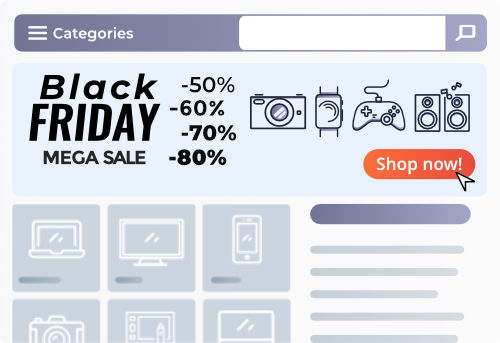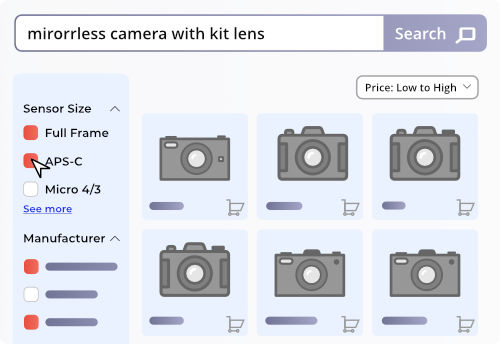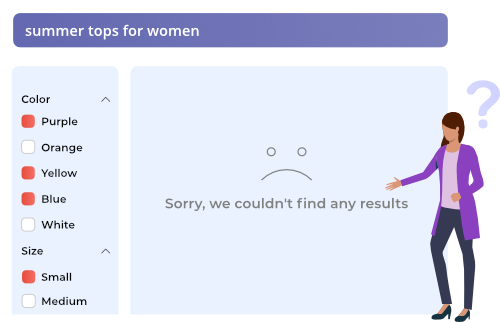How to Increase Revenue with B2B Search
While eCommerce search function is important for every webstore, it plays a different role on B2B shops than it does on B2C. In order to fully optimize your site for conversions and revenue, it’s important to understand the function of search on your site and how you can leverage its full potential.

Differences between B2B and B2C search
When outlining the differences between B2B and B2C search, it’s important to start by thinking about each site’s customer profile.
People shopping on B2C websites are shopping for themselves or for friends. They’ve either arrived to your site with an idea of what they’re looking for or are happy to just browse around.


If they’re using your search function, they’re looking for something particular although it could be something vague like ‘black shoes’. These shoppers are often open to seeing different/related product suggestions and will frequently order something they didn’t initially intend to purchase.
On B2B sites, people aren’t necessarily browsing as much as they are placing an order. They’re often re-ordering something they’ve already purchased for their company or want to stock in their shop. They know the brand, product SKU number, and exact items to buy.
They aren’t usually open to browsing around and will almost never buy something they didn’t initially intend to. They order about 4X as many products as B2C shoppers.
In this way, due to the high number of different products and shopper’s specific needs, search on a B2B site is incredibly important as it plays an integral part in quickly (and accurately) directing shoppers to the product(s) they’re looking to buy.
That’s why 95% of B2B shoppers use the search function, while only 20% of B2C shoppers do. The intent to purchase for users who use the search function is 3-4x higher than users who just browse. This explains the huge difference between B2B and B2C sites.
B2B product catalogues are also significantly larger than B2C product catalogues. For example, an average product catalog for a large B2C site contains around 10,000X products, while a B2B product catalog contains 100,000X products.
With such a wide range of products, it’s virtually impossible for a shopper to navigate to products on a B2B site without the use of search and oftentimes, category navigation is not a viable solution for product discovery.
Search on a B2B site is a key driver in providing shoppers with a great and efficient experience.
With the wide volume of available products and the predictability of shopper orders, search gets shoppers to where they want to go. The importance of B2B search is clearly visible in the 95% use rate. If your B2B search isn’t optimized, you could be missing out on a lot of revenue.
So let’s dive into some best practices on how to properly optimize your search.
B2B Search Best Practices
Now that you see how important search is on a B2B site, let’s dive into some of the best practices. By optimizing your search accordingly, you can effectively increase your conversion rate and online revenue.
Focus on accuracy
The B2B shopper is on a mission to complete an order. They have their shopping list ready and want to get in and out as fast as possible; so accurate results from the beginning are critical to providing a great experience.
Your Autocomplete makes the first impression and can save a shopper a lot of time, so it’s important it’s optimized for speed and accuracy.
In order to meet customer expectations, you need a strong Autocomplete with a deep understanding of natural language that can accurately decipher typos.
- Your Autocomplete needs to follow the general guidelines: Be prominently featured at the top of the page and be wide enough to support your typical search queries.
- It should recommend popular keywords and products as soon as someone focuses in and it should never suggest products or keywords that you don’t carry or are out of stock.
To further improve accuracy, your Autocomplete needs to be able to understand and process all the ways your shoppers search. Some people will search by brand name, some by product specifications, and others by product ID number – your Autocomplete needs to be able to understand all of this and provide meaningful results.
You need a Search Engine that can accurately display search results based on accuracy and popularity. In order to stay up to date, it should update these rankings at least daily, with more frequent catalog updates.
In order to get amazing accuracy, it’s important to leverage the latest search technologies. As they become more widely adopted, it helps your store stay relevant and provide a better user experience than your competitors.
Leverage ML and NLP
Machine Learning and Natural Language Processing, while buzzwords, are essential in adding value to your search results. When leveraged correctly, these technologies will increase the number of accurate search results, which enable more shoppers to find the products they’re looking for.
Natural Language Processing technology enables search engines to deeply understanding search queries and user intent, which ultimately provides shoppers with more, and more relevant search results.
A great way to bolster your NLP search is by adding relevant synonyms to keywords and products or to leverage a synonym database, which does this automatically.
A search leveraging Machine Learning continually optimizes search results based on executed queries and aggregated user behavior.
With this, search results are updated frequently (or in real time) based on how people are interacting with them (e.g.: search result clicks, add to basket and order actions). For example, products that are often purchased in after a certain executed query will become more closely related and will show up higher on the Search Engine Results Page when the query is executed in the future.
Machine Learning algorithms are an effective way to mine through a complex amount of data to add coherence to search patterns.
These are incredibly effective ways of reducing the 0-result rate on your site. Landing on a 0-results page is one of the worst experiences a shopper can have as you’re telling them you don’t carry the product they want to purchase. They, therefore, will take their business elsewhere and you miss out on an extra sale.

By leveraging NLP and ML, you’re able to significantly reduce your 0-result rate and increase your online revenue (by increasing the average order value for the B2B shopper), all while providing your customers with a better shopping experience.
Improve product findability
While strong merchandising features and dependence on search filters come to mind when thinking about optimizing a B2C webshop, they also play an important role in B2B webshops due to the immense size of product catalogues. Improving product findability allows shoppers to quickly make a purchase and thus increases your online revenue.

Filters are an essential way shoppers sort through products on the search results page to find what they’re looking to buy.
You should leverage dynamic filtering, filters that change based on product results shown, to allow shoppers to narrow down a wide range of results. For example, someone shopping for laptops may want to filter by brand, size, processing power; while someone shopping for printer ink would need to filter results based on printer type.
Since shoppers aren’t able to effectively navigate your store manually, it’s important that you have the ability to promote products on sale.
If you’re looking for an enterprise eCommerce search provider, make sure you select one that allows you to set rules to boost specific products, keywords, or even categories (depending on your business, you may also want to be able to do this based on different geographic locations).
By providing intuitive filters and leveraging merchandising, shoppers are better able to find the products they’re looking to buy and will be more likely to make a purchase; increasing your bottom line.
Leverage data
While all of the previously mentioned tactics are important to use in your B2B shop, the most important thing you can do is utilize data.
Monitoring the performance of your b2b search with detailed analytics, is one of the most essential things you can do to optimize it.
When looking to implement an analytics tool – you need something that tracks search metrics more in-depth than Google Analytics. Oftentimes, site search providers will offer these tools for free, so do a basic Google search and evaluate offers.
The benefits of frequently checking your b2b search analytics isn’t just better for improving your bottom line.
This insight also benefits other departments. For example, marketing can get insight into customer language by checking the words they use when searching for products. This can then be used in newsletters or in PPC campaigns to make marketing more effective.
Analytics is the basis for a strong b2b search and shouldn’t be something you overlook.
Get Personal
When optimizing your B2B search, think about adding some elements of personalization. Frequently, B2B shoppers return to the same site to place the same order monthly or quarterly. In the B2B industry, the rate of return customers is high, so you should consider personalizing your search by recommending previously searched/purchased products in the Autocomplete or saving previous orders.
You could also customize product recommendations on 0-results pages. You could do this by suggesting other previously purchased products or highlight related (or complementary) products/keywords, so they can navigate to a product page with just a click.
This makes the shopping journey even easier and faster for your customers and provides them with a seamless shopping experience that boosts your online revenue.
Summary
Search on a B2B website is critically important as more than 90% of shoppers interact with it at some point during their shopping journey.
In order to provide your customers with the best experience possible, you need to focus on a few key areas. Most importantly, your b2b search should be accurate and typo-tolerant, you should leverage the latest technologies, implement dynamic filtering and personalization, and monitor results and adjust accordingly based on detailed analytics.
While it can seem overwhelming to optimize the nuances of search, site search providers are able to help and are often happy to suggest some best practices or ways to improve your existing store.


